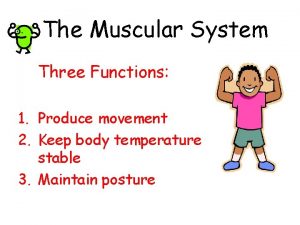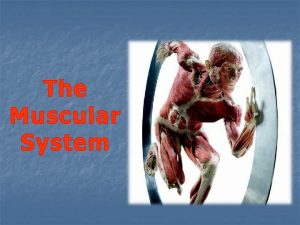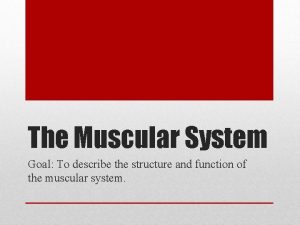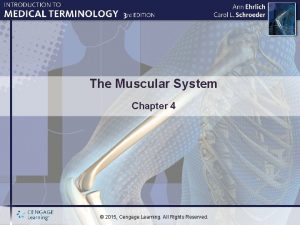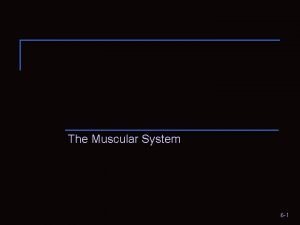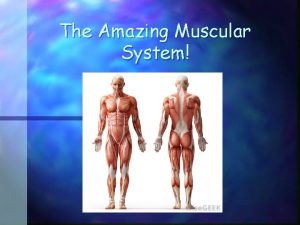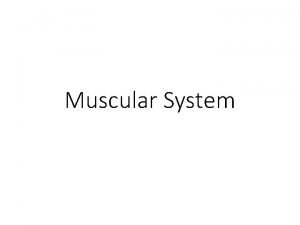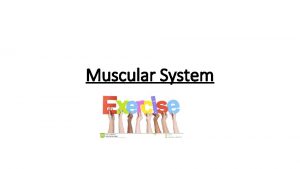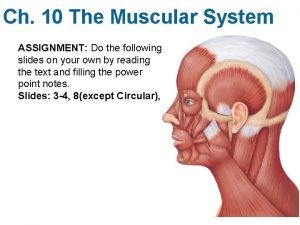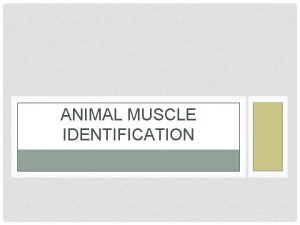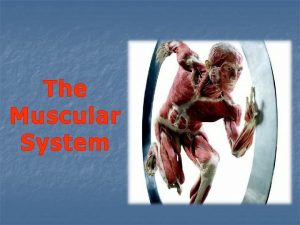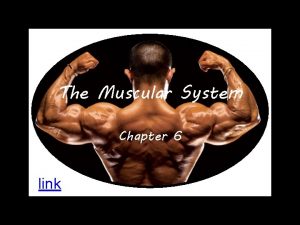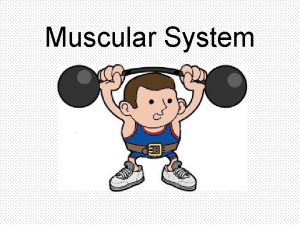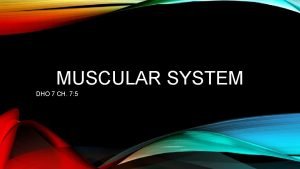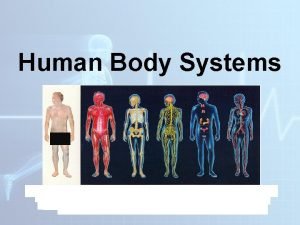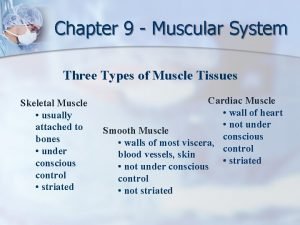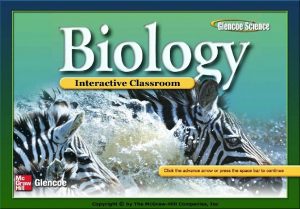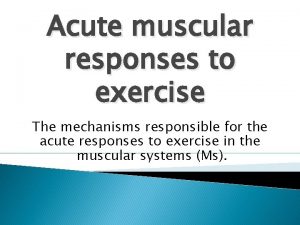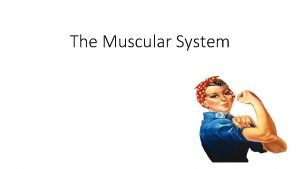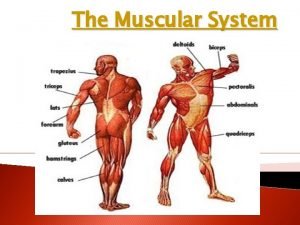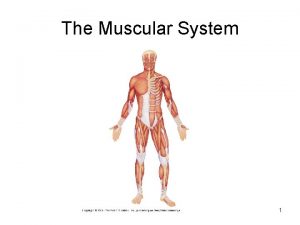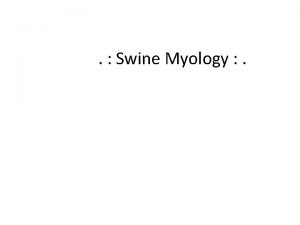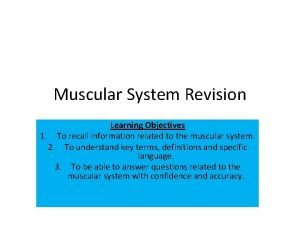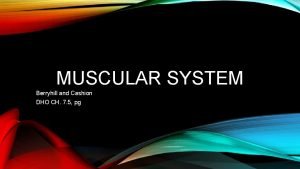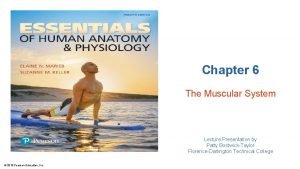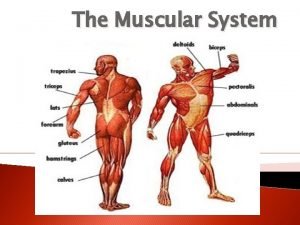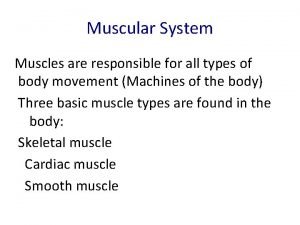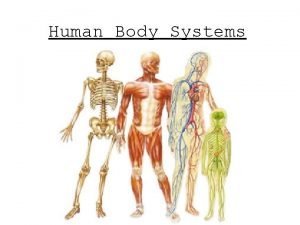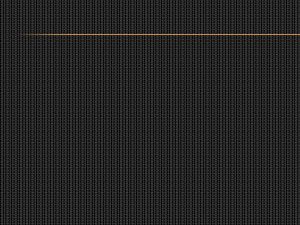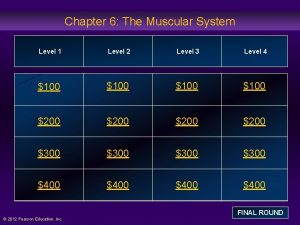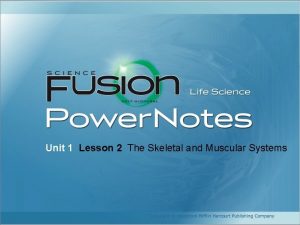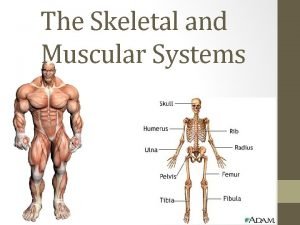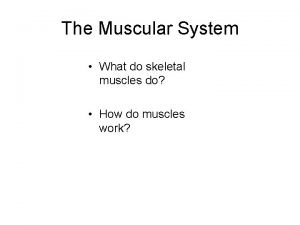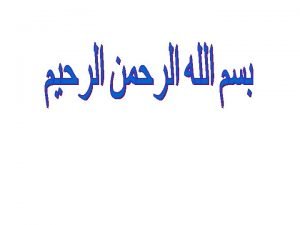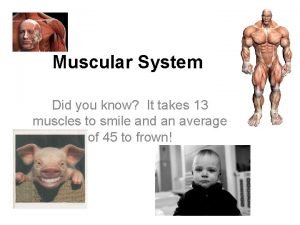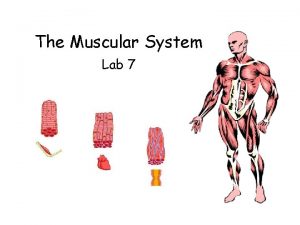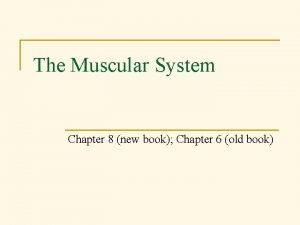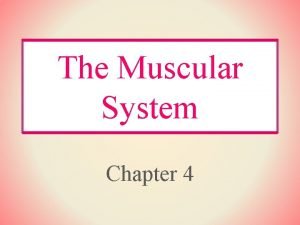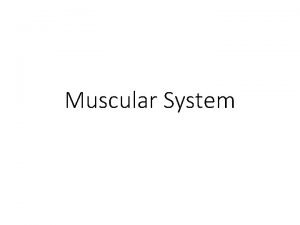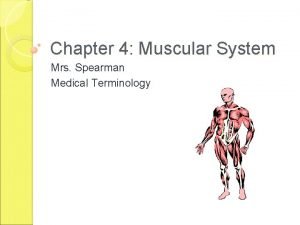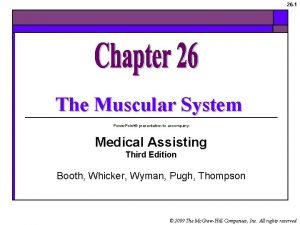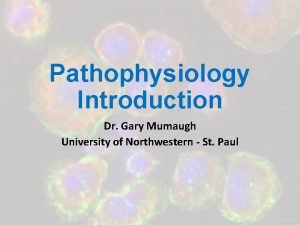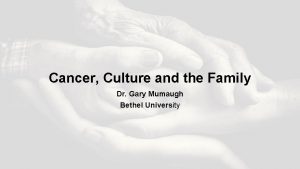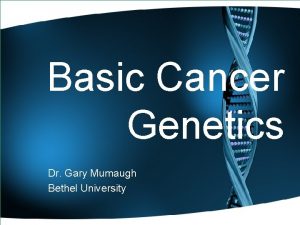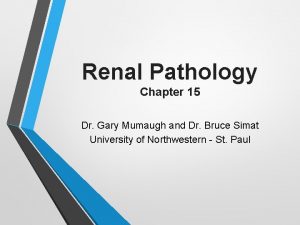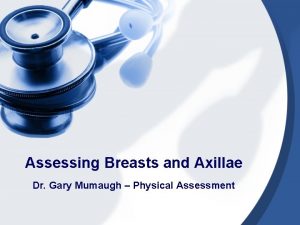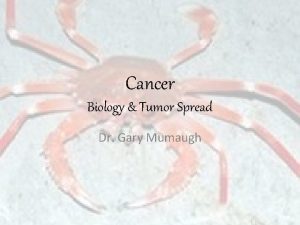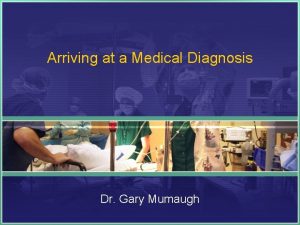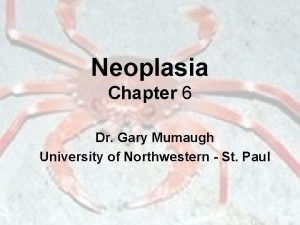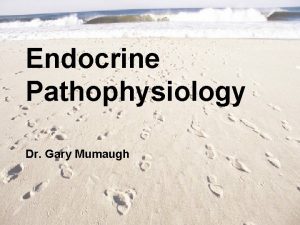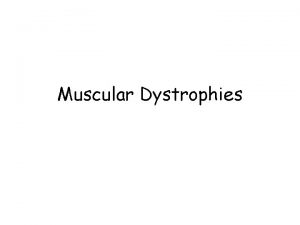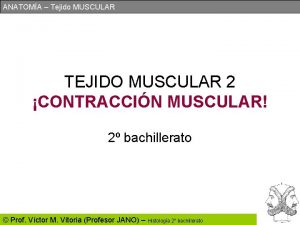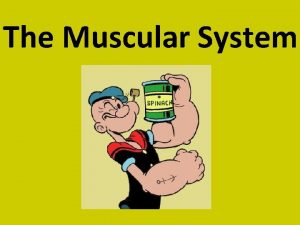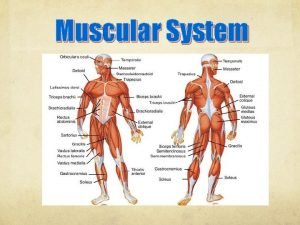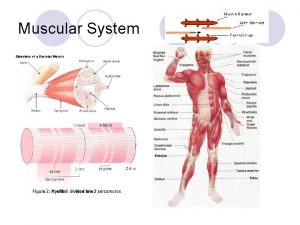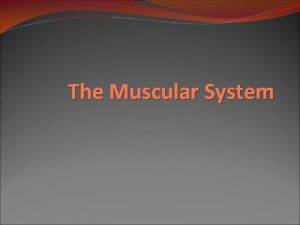Muscular System Dr Gary Mumaugh The Muscular System
































































































- Slides: 96

Muscular System Dr. Gary Mumaugh

The Muscular System • Structural and functional organization of muscles . Superficial Deep Frontalis Orbicularis oculi Masseter Zygomaticus major Orbicularis oris Sternocleidomastoid Platysma Trapezius Pectoralis minor • Muscles of the head and neck Deltoid Coracobrachialis Pectoralis major Serratus anterior Brachialis Biceps brachii Rectus abdominis Supinator Flexor digitorum profundus Flexor pollicis longus Brachioradialis Flexor carpi radialis • Muscles of the trunk • Muscles acting on the shoulder and upper limb • Muscles acting on the hip and lower limb Transverse abdominal External abdominal oblique Tensor fasciae latae Internal abdominal oblique Pronator quadratus Adductor longus Sartorius Adductors Rectus femoris Vastus lateralis Vastus intermedius Gracilis Vastus medialis Fibularis longus Gastrocnemius Tibialis anterior Soleus Extensor digitorum longus (a) Anterior view

Anterior View • The 40 superficial muscles here are divided into 10 regional areas of the body

Posterior View • The 27 superficial muscles here are divided into seven regional areas of the body

Organization of Muscles • about 600 human skeletal muscles • constitute about half of our body weight • three kinds of muscle tissue ▫ skeletal, cardiac, smooth • specialized for one major purpose ▫ converting the chemical energy in ATP into the mechanical energy of motion • myology – the study of the muscular system

The Functions of Muscles • Movement ▫ move from place to place, movement of body parts and body contents in breathing, circulation, feeding and digestion, defecation, urination, and childbirth ▫ role in communication – speech, writing, and nonverbal communications • Stability ▫ maintain posture by preventing unwanted movements ▫ antigravity muscles – resist the pull of gravity and prevent us from falling or slumping over ▫ stabilize joints

• Control of openings and passageways ▫ sphincters – internal muscular rings that control the movement of food, bile, blood, and other materials • Heat production by skeletal muscles ▫ as much as 85% of our body heat

Connective Tissues of a Muscle Tendon Fascia Skeletal muscle Muscle fascicle Nerve Blood vessels Epimysium Perimysium Endomysium Muscle fiber Muscle fascicle Perimysium Muscle fiber (a)

Connective Tissues of a Muscle • endomysium ▫ thin sleeve of loose connective tissue surrounding each muscle fiber ▫ allows room for capillaries and nerve fibers to reach muscle fiber • perimysium ▫ slightly thicker layer of connective tissue ▫ fascicles – bundles of muscle fibers wrapped in perimysium ▫ carry larger nerves and blood vessels, and stretch receptors

• epimysium ▫ fibrous sheath surrounding the entire muscle ▫ outer surface grades into the fascia ▫ inner surface sends projections between fascicles to form perimysium • fascia ▫ sheet of connective tissue that separates neighboring muscles or muscle groups from each other and the subcutaneous tissue

Fascicle Orientation of Muscles Triangular Unipennate Bipennate Parallel Multipennate Fusiform Tendon Circular Belly Pectoralis major Tendon Rectus abdominis Biceps brachii Palmar interosseous Rectus femoris Deltoid Orbicularis oculi strength of a muscle and the direction of its pull are determined partly by the orientation of its fascicles.

Muscle Attachments • indirect attachment to bone ▫ tendons bridge the gap between muscle ends and bony attachment �the collagen fibers of the endo-, peri-, and epimysium continue into the tendon �from there into the periosteum and the matrix of bone �very strong structural continuity from muscle to bone �aponeurosis – tendon is a broad, flat sheet (palmar aponeurosis • direct (fleshy) attachment to bone ▫ little separation between muscle and bone ▫ muscle seems to immerge directly from bone ▫ margins of brachialis, lateral head of triceps brachii • some skeletal muscles do not insert on bone, but in dermis of the skin – muscles of facial expression

• Origin ▫ bony attachment at stationary end of muscle • Belly ▫ thicker, middle region of muscle between origin and insertion Origins Scapula Origins Humerus Bellies Extensors: Triceps brachii Long head Flexors: Biceps brachii Brachialis Lateral head • Insertion ▫ bony attachment to mobile. Insertion end of muscle Insertion Radius Ulna

Functional Groups of Muscles • action – the effects produced by a muscle ▫ to produce or prevent movement • prime mover (agonist) - muscle that produces most of force during a joint action • synergist - muscle that aids the prime mover ▫ stabilizes the nearby joint ▫ modifies the direction of movement • antagonist - opposes the prime mover ▫ relaxes to give prime mover control over an action ▫ preventing excessive movement and injury

Functional Muscle Groups. • prime mover - brachialis Origins Scapula Origins Humerus • synergist - biceps brachii Bellies Extensors: Triceps brachii Long head • antagonist - triceps brachii Flexors: Biceps brachii Brachialis Lateral head Insertion Radius Ulna • fixator - muscle that holds scapula firmly in place ▫ rhomboids

Intrinsic and Extrinsic Muscles Common flexor tendon Flexor digitorum superficialis Flexor pollicis longus Flexor digitorum superficialis tendons Flexor digitorum profundus tendons (b) Intermediate flexor • intrinsic muscles – entirely contained within a region, such as the hand ▫ both its origin and insertion there • extrinsic muscles – act on a designated region, but has its origin elsewhere ▫ fingers – extrinsic muscles in the forearm . First dorsal interosseous Tendon sheath Tendon of flexor digitorum profundus Tendon of flexor digitorum superficialis Lumbricals Opponens digiti minimi Adductor pollicis Tendon of flexor pollicis longus Flexor pollicis brevis Flexor digiti Abductor pollicis brevis Abductor digiti minimi Opponens pollicis Flexor retinaculum Tendons of: Abductor pollicis longus Flexor carpi radialis Flexor pollicis longus Tendons of: Flexor carpi ulnaris Flexor digitorum superficialis Palmaris longus (a) Palmar aspect, superficial

Muscle Innervation • innervation of a muscle – refers to the identity of the nerve that stimulates it ▫ enables the diagnosis of nerve, spinal cord, and brainstem injuries from their effects on muscle function • spinal nerves arise from the spinal cord ▫ emerge through intervertebral foramina ▫ immediately branch into a posterior and anterior ramus ▫ innervate muscles below the neck • cranial nerves arise from the base of the brain ▫ emerge through skull foramina ▫ innervate the muscles of the head and neck ▫ numbered I to XII

Muscles of Facial Expression • muscles that insert in the dermis and subcutaneous tissues • tense the skin and produce facial expressions • innervated by facial nerve (CN VII) • paralysis causes face to sag • found in scalp, forehead, around the eyes, nose and mouth, and in the neck

10 -19 Muscles in Facial Expression

10 -20

Muscles of Chewing and Swallowing • extrinsic muscles of the tongue ▫ tongue is very agile organ ▫ pushes food between molars for chewing (mastication) ▫ forces food into the pharynx for swallowing (deglutition) ▫ crucial importance to speech • intrinsic muscles of tongue ▫ vertical, transverse, and longitudinal fascicles Styloid process Palatoglossus Mastoid process Styloglossus Posterior belly of digastric (cut) Superior pharyngeal constrictor (cut) Inferior longitudinal muscle of tongue Stylohyoid Middle pharyngeal constrictor Genioglossus Hyoglossus Mylohyoid (cut) Hyoid bone Geniohyoid Larynx Inferior pharyngeal constrictor Trachea Esophagus

Muscles of Chewing • four pairs of muscles produce the biting and chewing movements of the mandible ▫ depression – to open mouth ▫ elevation – biting and grinding ▫ protraction – incisors can cut ▫ retraction – make rear teeth meet ▫ lateral and medial excursion – grind food • temporalis, masseter, medial pterygoid, lateral pterygoid • innervated by mandibular nerve which is a branch of the trigeminal (V) . Temporalis Orbicularis oris Buccinator Masseter (cut) (a) Lateral view Lateral pterygoid plate Medial pterygoid plate Lateral pterygoid muscle Medial pterygoid muscle Interior of oral cavity (b) Posterior view

10 -23

Muscles Acting on the Head • originate on the vertebral column, thoracic cage, and pectoral girdle • insert on the cranial bones • actions ▫ flexion (tipping head forward) �sternocleidomastoid �scalenes ▫ extension (holding the head erect) �trapezius �splenius capitis �semispinalis capitis

• Actions ▫ lateral flexion (tipping head to one side) ▫ rotation (turning the head to the left and right) • may cause contralateral movement – movement of the head toward the opposite side • may cause ipsilateral movement – movement of the head toward the same side

Muscles of the Face

Muscles of the Neck: Head Movements


Triangles of the Neck Anterior triangles A 1. Muscular A 2. Carotid A 3. Submandibular A 4. Suprahyoid Posterior triangles P 1. Occipital P 2. Omoclavicular Sternocleidomastoid A 4 A 3 A 2 P 1 A 1 P 2

Muscles of the Trunk • three functional groups ▫ muscles of respiration ▫ muscles that support abdominal wall and pelvic floor ▫ movement of vertebral column

Muscles of Respiration • breathing requires the use of muscles enclosing thoracic cavity ▫ diaphragm, external and internal intercostal, • inspiration – air intake • expiration – expelling air • other muscles of chest and abdomen that contribute to breathing ▫ ▫ sternocleidomastoid, scalenes of neck pectoralis major and serratus anterior of chest latissimus dorsi of back abdominal muscles – internal and external obliques, and transverse abdominis ▫ some anal muscles

Muscles of Respiration - Diaphragm • muscular dome between thoracic and abdominal cavities • muscle fascicles extend to a fibrous central tendon • contraction flattens diaphragm – enlarges thoracic cavity (inspiration) • in relaxation of diaphragm it rises – shrinks the thoracic cavity (expiration) Xiphoid process of sternum Inferior vena cava Ribs Esophagus Central tendon of diaphragm Aorta Vertebral column (b) Inferior view of diaphragm

Muscles of Respiration - Intercostals. • external intercostals ▫ elevates ribs ▫ expand thoracic cavity ▫ create partial vacuum causing inflow of air • internal intercostals ▫ depresses and retracts ribs ▫ compresses thoracic cavity ▫ expelling air External intercostals Internal intercostals (a) Lateral view of intercostal muscles

Muscles of the Anterior Abdominal Wall • four pairs of sheetlike muscles ▫ ▫ external abdominal oblique internal abdominal oblique transverse abdominal rectus abdominis • strengthen abdominal wall . Posterior Muscles: External abdominal oblique Anterior Internal abdominal oblique Peritoneum Transverse abdominal Rectus abdominis Subcutaneous fat Rectus sheath Linea alba Skin Aponeurosis of Transverse abdominal Internal abdominal oblique External abdominal oblique 10 -34

Muscles of the Abdominal Wall Figure 10. 11 a

external abdominal oblique • • most superficial of lateral abdominal muscles supports abdominal viscera against pull of gravity stabilizes vertebral column during heavy lifting maintains posture compresses abdominal organs aids in forced expiration rotation at waist Pectoralis major Latissimus dorsi Serratus anterior Tendinous intersections Rectus sheath (cut edges) Rectus sheath Transverse abdominal Umbilicus Internal abdominal oblique (cut) Linea semilunaris Linea alba External abdominal oblique (cut) Rectus abdominis Aponeurosis of external abdominal oblique Inguinal ligament (a) Superficial

internal abdominal oblique • intermediate layer of lateral abdominal muscles • unilateral contraction causes ipsilateral rotation of waist • aponeurosis – tendons of oblique and transverse muscles –broad, fibrous sheets Subclavius Pectoralis minor (cut) Pectoralis minor Internal intercostals Serratus anterior External intercostals Rectus abdominis (cut) Rectus sheath External abdominal oblique (cut) Internal abdominal oblique Posterior wall of rectus sheath (rectus abdominis removed) Inguinal ligament Transverse abdominal (cut) (b) Deep

transverse abdominal • • deepest of lateral abdominal muscles horizontal fibers compresses abdominal contents contributes to movements of vertebral column Subclavius Pectoralis minor (cut) Pectoralis minor Internal intercostals Serratus anterior External intercostals Rectus abdominis (cut) Rectus sheath External abdominal oblique (cut) Internal abdominal oblique Posterior wall of rectus sheath (rectus abdominis removed) Inguinal ligament Transverse abdominal (cut) (b) Deep

rectus abdominis • • • flexes lumbar region of vertebral column produces forward bending at the waist extends from sternum to pubis rectus sheath encloses muscle three transverse tendinous intersections divide rectus abdominis into segments – “six pack” Copyright © The Mc. Graw-Hill Companies, Inc. Permission required for reproduction or display. Pectoralis major Latissimus dorsi Serratus anterior Tendinous intersections Rectus sheath (cut edges) Rectus sheath Transverse abdominal Umbilicus Internal abdominal oblique (cut) Linea semilunaris Linea alba External abdominal oblique (cut) Rectus abdominis Aponeurosis of external abdominal oblique Inguinal ligament (a) Superficial

Superficial Muscles of Back. Superficial Deep Semispinalis capitis Sternocleidomastoid Splenius capitis Trapezius Levator scapulae Rhomboideus minor Rhomboideus major Supraspinatus Deltoid Infraspinatus Teres minor Teres major Erector spinae Serratus anterior extend, rotate, and laterally flex vertebral column Serratus posterior inferior Latissimus dorsi External abdominal oblique Thoracolumbar fascia Internal abdominal oblique Gluteus medius Gluteus minimus Gluteus maximus Lateral rotators upper limb movement


Deep Muscles of the Back . • erector spinae ▫ iliocostalis, longissimus, spinalis ▫ from cranium to sacrum ▫ extension and lateral flexion of vertebral column • semispinalis thoracis ▫ extension and contralateral rotation of vertebral column • quadratus lumborum ▫ aids respiration ▫ ipsilateral flexion of lumbar vertebral column • multifidus ▫ stabilizes adjacent vertebrae ▫ maintains posture Superior nuchal line Longissimus capitis Splenius capitis Semispinalis cervicis Serratus posterior superior Splenius cervicis Erector spinae: Iliocostalis Semispinalis thoracis Longissimus Spinalis Serratus posterior inferior Internal abdominal oblique External abdominal oblique (cut) Multifidus Quadratus lumborum

Deep Back Muscles

Muscles of the Pelvic Floor • three layers of muscles and fasciae that span pelvic outlet ▫ penetrated by anal canal, urethra, and vagina • perineum – diamond-shaped region between the thighs ▫ bordered by four bony landmarks ▫ urogenital triangle – anterior half of perineum ▫ anal triangle – posterior half of perineum • three layers or compartments of the perineum ▫ superficial perineal space – three muscles �ischiocavernosus, bulbospongiosus, superficial transverse peritoneal ▫ middle compartment - spanned by urogenital diaphragm �composed of a fibrous membrane and two or three muscles �deep transverse perineal muscle, external urethral and anal sphincters �compressor urethrae in females only ▫ pelvic diaphragm – deepest layer consists of two muscle pairs �levator ani and coccygeus

Superficial Perineal Space. Male Ischiocavernosus Perineal raphe Bulbospongiosus Superficial transverse perineal muscle Levator ani Gluteus maximus (a) Superficial perineal space, inferior view • muscles found just deep to the skin • ischiocavernosus – maintains erection • bulbospongiosus – aids in erection, expels remaining urine

Muscles of Pelvic Diaphragm Pubic symphysis Pubic ramus External urethral sphincter Deep transverse perineal muscle Perineal body External anal sphincter (b) Urogenital diaphragm, inferior view • deepest compartment of the perineum • pelvic diaphragm – two muscle pairs ▫ levator ani - supports viscera and defecation ▫ coccygeus - supports and elevates pelvic floor

Hernias • hernia – any condition in which the viscera protrudes through a weak point in the muscular wall of the abdominopelvic cavity • inguinal hernia ▫ most common type of hernia (rare in women) ▫ viscera enter inguinal canal or even the scrotum • hiatal hernia ▫ stomach protrudes through diaphragm into thorax ▫ overweight people over 40 • umbilical hernia ▫ viscera protrude through the navel

Muscles Acting on Shoulder and Upper Limb • compartments – spaces in which muscles are organized and are separated by fibrous connective tissue sheets (fasciae) ▫ each compartment contains one or more functionally related muscles along with their nerve and blood supplies • muscles of upper limbs divided into anterior and posterior compartments • muscles of lower limbs divided into anterior, posterior, medial, and lateral compartments • compartment syndrome – one of the muscles or blood vessels in a compartment is injured

Compartment Syndrome • fasciae of arms and legs enclose muscle compartments very snugly • if a blood vessel in a compartment is damaged, blood and tissue fluid accumulate in the compartment • fasciae prevent compartment from expanding with increasing pressure • compartment syndrome – mounting pressure on the muscles, nerves and blood vessel triggers a sequence of degenerative events ▫ blood flow to compartment is obstructed by pressure ▫ if ischemia (poor blood flow) persists for more than 2 – 4 hours, nerves begin to die ▫ after 6 hours, muscles begin to die • nerves can regenerate after pressure relieved, but muscle damage is permanent • myoglobin in urine indicates compartment syndrome • treatment – immobilization of limb and fasciotomy – incision to relieve compartment pressure

Muscles Acting on the Shoulder • originate on the axial skeleton • insert on clavicle and scapula • scapula loosely attached to thoracic cage ▫ capable of great movement ▫ rotation, elevation, depression, protraction, retraction • clavicle braces the shoulder and moderates movements

Anterior Muscles of Pectoral Girdle • pectoralis minor • serratus anterior ▫ ribs 1 -9 to medial border of scapula ▫ abducts and rotates or depresses scapula ▫ ribs 3 -5 to coracoid process of scapula ▫ draws scapula laterally Subclavius Pectoralis minor (cut) Pectoralis minor Internal intercostals Serratus anterior External intercostals Rectus abdominis (cut) Rectus sheath External abdominal oblique (cut) Internal abdominal oblique Posterior wall of rectus sheath (rectus abdominis removed) Inguinal ligament Transverse abdominal (cut) (b) Deep

Muscles Acting on Scapula. Lateral rotation Trapezius (superior part) Serratus anterior Elevation Levator scapulae Trapezius (superior part) Rhomboideus major Rhomboideus minor Medial rotation Levator scapulae Rhomboideus major Rhomboideus minor Depression Trapezius (inferior part) Serratus anterior Retraction Rhomboideus major Rhomboideus minor Trapezius Protraction Pectoralis minor Serratus anterior

Posterior Muscles of Pectoral Girdle • four muscles of posterior group . Superficial ▫ trapezius - superficial ▫ levator scapulae, rhomboideus minor, and rhomboideus major - deep • trapezius Semispinalis capitis Sternocleidomastoid Splenius capitis Trapezius ▫ stabilizes scapula and shoulder ▫ elevates and depresses shoulder apex Deltoid • levator scapulae ▫ elevates scapula ▫ flexes neck laterally • rhomboideus minor ▫ retracts scapula and braces shoulder • rhomboideus major Deep Erector spinae Levator scapulae Rhomboideus minor Rhomboideus major Supraspinatus Infraspinatus Teres minor Teres major Serratus anterior Serratus posterior inferior Latissimus dorsi External abdominal oblique Thoracolumbar fascia Internal abdominal oblique Gluteus medius Gluteus minimus Gluteus maximus Lateral rotators ▫ same as rhomboideus minor 10 -53



10 -56

Muscles Acting on Arm • nine muscles cross the shoulder joint and insert on humerus • two are axial muscles because they originate on axial skeleton ▫ pectoralis major – flexes, adducts, and medially rotates humerus ▫ latissimus dorsi – adducts and medially rotated humerus. . Supraspinatus Deltoid Clavicle Spine of scapula Sternum Greater tubercle of humerus Infraspinatus Humerus Pectoralis major Teres minor Teres major Triceps brachii: Lateral head Long head Coracobrachialis Lateral head Long head Medial head Biceps brachii Latissimus dorsi Brachialis Brachioradialis (a) Anterior view (b) Posterior view


Muscles Acting on Arm • seven scapular muscles • originate on scapula ▫ deltoid �rotates and abducts arm �intramuscular injection site ▫ teres major �extension and medial rotation of humerus ▫ coracobrachialis �flexes and medially rotates arm ▫ remaining four form the rotator cuff that reinforce the shoulder joint Copyright © The Mc. Graw-Hill Companies, Inc. Permission required for reproduction or display. Clavicle Sternum Deltoid Pectoralis major Triceps brachii: Lateral head Long head Medial head Coracobrachialis Biceps brachii Brachialis Brachioradialis (a) Anterior view Supraspinatus Spine of scapula Greater tubercle of humerus Infraspinatus Humerus Teres minor Teres major Triceps brachii: Lateral head Long head Latissimus dorsi (b) Posterior view

Rotator Cuff Muscles • tendons of the remaining four scapular muscles form the rotator cuff • “SITS” muscles – for the first letter of their names ▫ supraspinatus ▫ infraspinatus ▫ teres minor ▫ subscapularis • tendons of these muscles merge with the joint capsule of the shoulder as they cross it in route to the humerus • holds head of humerus into glenoid cavity • supraspinatus tendon most easily damaged

10 -61 Rotator Cuff Muscles Anterior Rotator cuff (SITS) muscles: Supraspinatus Infraspinatus Teres minor Posterior Clavicle Acromion Coracoid process Glenoid cavity Subscapularis Inferior angle


Muscles Acting on Forearm • elbow and forearm capable of flexion, extension, pronation, and supination ▫ carried out by muscles in both brachium (arm) and antebrachium (forearm) • muscles with bellies in the arm (brachium) ▫ principal elbow flexors – anterior compartment �brachialis and biceps brachii �brachialis produces 50% more power than biceps brachii �brachialis is prime mover of elbow flexion ▫ principal elbow extensor – posterior compartment �triceps brachii �prime mover of elbow extension

Muscles Acting on Forearm • muscles with bellies in the forearm (antebrachium) • most forearm muscles act on the hand wrist ▫ ▫ ▫ brachioradialis – flexes elbow anconeus – extends elbow pronator quadratus – prime mover in forearm pronation pronator teres – assists pronator quadratus in pronation supinator – supinates the forearm

Muscles Acting on Forearm Copyright © The Mc. Graw-Hill Companies, Inc. Permission required for reproduction or display. • principal flexor ▫ brachialis Biceps brachii: Long head Short head Copyright © The Mc. Graw-Hill Companies, Inc. Permission required for reproduction or display. • synergistic flexors ▫ biceps brachii ▫ brachioradialis Clavicle Sternum Deltoid Pectoralis major Triceps brachii: Lateral head Long head Medial head Biceps brachii Brachialis Brachioradialis Coracobrachialis (c) Anterior view Copyright © The Mc. Graw-Hill Companies, Inc. Permission required for reproduction or display. Supraspinatus • principal extensor ▫ triceps brachii Spine of scapula Greater tubercle of humerus Infraspinatus Humerus Teres minor (a) Anterior view Teres major Triceps brachii: Lateral head Long head Latissimus dorsi (b) Posterior view 10 -65



Supination and Pronation Copyright © The Mc. Graw-Hill Companies, Inc. Permission required for reproduction or display. Lateral epicondyle Medial epicondyle Supinator Pronator teres Ulna Radius Pronator quadratus Biceps brachii Radius Bursa Supinator Bursa Ulna (b) Muscle actions in supination (a) Supination supination • supinator muscle • palm facing anteriorly or superiorly (c) Pronation pronation • pronator quadratus and pronator teres • palm faces posteriorly or inferiorly

Anterior Muscles on Wrist and Hand • extrinsic muscles of the forearm • intrinsic muscles in the hand itself • extrinsic muscle actions ▫ flexion and extension of wrist and digits ▫ radial and ulnar flexion ▫ finger abduction and adduction ▫ thumb opposition . Biceps brachii Triceps brachii Brachialis Common flexor tendon Pronator teres Aponeurosis of biceps brachii Brachioradialis Flexor carpi radialis Palmaris longus Flexor carpi ulnaris Anterior view Interosseous membrane Extensor carpi radialis longus and brevis Flexor digitorum superficialis Flexor retinaculum Palmar aponeurosis (a) Superficial flexors (b) Intermediate flexor Supinator Flexor digitorum superficialis Flexor digitorum profundus Flexor pollicis longus Flexor digitorum superficialis tendons Flexor digitorum profundus tendons (c) Deep flexors

Anterior Muscles on Wrist and Hand • Anterior (Flexor) Compartment – superficial layer ▫ ▫ flexor carpi radialis flexor carpi ulnaris flexor digitorum superficialis palmaris longus • Anterior (Flexor) Compartment – deep layer ▫ flexor digitorum profundus ▫ flexor pollicis longus

10 -71

Posterior Muscles on Wrist & Hand • extension of wrist and fingers, adduct / abduct wrist • extension and abduction of thumb (pollicis) • brevis - short, ulnaris - on ulna side of forearm Triceps brachii Brachioradialis Olecranon Extensor carpi radialis longus Anconeus Posterior view Anconeus Supinator Extensor carpi radialis brevis Flexor carpi ulnaris Abductor pollicis longus Extensor digitorum Extensor carpi ulnaris Abductor pollicis longus Extensor digiti minimi Extensor pollicis brevis Extensor pollicis longus Extensor pollicis brevis Extensor indicis Extensor pollicis longus Tendon of extensor indicis Tendons of extensor carpi radialis longus and brevis Tendons of extensor digitorum (a) Superficial extensors (b) Deep extensors

Posterior Muscles on Wrist and Hand • Posterior (Extensor) Compartment – superficial layer ▫ ▫ ▫ extensor carpi radialis longus extensor carpi radialis brevis extensor digitorum extensor digiti minimi extensor carpi ulnaris • Posterior (Extensor) Compartment – deep layer ▫ ▫ abductor pollicis longus extensor pollicis brevis extensor pollicis longus extensor indicis

Carpal Tunnel Syndrome • flexor retinaculum – bracelet-like fibrous sheet that the flexor tendons of the extrinsic muscles that flex the wrist pass on their way to their insertions • carpal tunnel – tight space between the flexor retinaculum and the carpal bones ▫ flexor tendons passing through the tunnel are enclosed in tendon sheaths �enable tendons to slide back and forth quite easily • carpal tunnel syndrome - prolonged, repetitive motions of wrist and fingers can cause tissues in the carpal tunnel to become inflamed, swollen, or fibrotic ▫ puts pressure on the median nerve of the wrist that passes through the carpal tunnel along with the flexor tendons ▫ tingling and muscular weakness in the palm and medial side of the hand ▫ pain may radiate to arm and shoulder ▫ treatment – anti-inflammatory drugs, immobilization of the wrist, and

Carpal Tunnel Syndrome repetitive motions cause inflammation and pressure on median nerve Tendon of flexor digitorum superficialis Lumbrical Opponens digiti minimi Adductor pollicis Flexor digiti minimi brevis Flexor pollicis brevis Abductor digiti minimi Abductor pollicis brevis Pisiform bone Tendon of extensor pollicis brevis Flexor digitorum superficialis Tendon of flexor carpi radialis Tendon sheath First dorsal interosseous Tendon of flexor digitorum profundus Adductor pollicis Tendon of flexor digitorum superficialis Lumbricals Opponens digiti minimi Flexor pollicis brevis Flexor digiti minimi brevis Abductor pollicis brevis Abductor digiti minimi Opponens pollicis Flexor retinaculum (b) Palmar dissection, superficial Tendon of flexor pollicis longus Tendons of: Flexor carpi ulnaris Flexor digitorum superficialis Palmaris longus Tendons of: Abductor pollicis longus Flexor carpi radialis Flexor pollicis longus (a) Palmar aspect, superficial 10 -75

10 -76

Intrinsic Hand Muscles • thenar group – form thick, fleshy mass at base of thumb ▫ ▫ adductor pollicis abductor pollicis brevis flexor pollicis brevis opponens pollicis • Hypothenar group - fleshy base of the little finger ▫ abductor digiti minimi ▫ flexor digiti minimi brevis ▫ opponens digiti minimi • Midpalmar group – hollow of palm ▫ dorsal interosseous muscles (4) ▫ palmar interosseous muscles (3) ▫ lumbricals (4 muscles) Tendon sheath First dorsal interosseous Tendon of flexor digitorum profundus Adductor pollicis Tendon of flexor digitorum superficialis Lumbricals Opponens digiti minimi Tendon of flexor pollicis longus Flexor pollicis brevis Flexor digiti minimi brevis Abductor pollicis brevis Abductor digiti minimi Opponens pollicis Flexor retinaculum Tendons of: Flexor carpi ulnaris Flexor digitorum superficialis Palmaris longus Tendons of: Abductor pollicis longus Flexor carpi radialis Flexor pollicis longus (a) Palmar aspect, superficial 10 -77

Muscles on the Hip and Lower Limb • largest muscles found in lower limb • less for precision, more for strength needed to stand, maintain balance, walk, and run • several cross and act on two or more joints • leg – the part of the limb between the knee and ankle • foot – includes tarsal region (ankle), metatarsal region, and the toes

Muscles Acting on the Hip and Femur. • anterior muscles of the hip ▫ iliacus �flexes thigh at hip �iliacus portion arises from iliac crest and fossa ▫ psoas major �flexes thigh at hip �arises from lumbar vertebrae ▫ they share a common tendon on the femur Iliopsoas: Iliacus Psoas major Piriformis Pectineus Adductor magnus Adductor brevis Adductor longus Gracilis Insertion of gracilis on tibia Obturator externus

10 -80

10 -81

Posterior Muscles on Hip and Femur • lateral and posterior muscles of the hip ▫ tensor fasciae latae �extends knee, laterally rotates knee ▫ gluteus maximus �forms mass of the buttock �prime hip extensor �provides most of lift when you climb stairs ▫ gluteus medius and minimus �abduct and medially rotate thigh Superficial Deep Iliac crest Gluteus medius Sacrum Gluteus maximus Coccyx Ischial tuberosity Gluteus minimus Lateral rotators: Piriformis Gemellus superior Obturator internus Obturator externus Gemellus inferior Quadratus femoris

10 -83

Posterior Muscles on Hip and Femur • lateral rotators - six muscles inferior to gluteus minimus • deep to the two other gluteal muscles ▫ ▫ ▫ gemellus superior gemellus inferior obturator externus obturator internus piriformis quadratus femoris Superficial Deep Iliac crest Gluteus medius Sacrum Gluteus maximus Coccyx Ischial tuberosity Gluteus minimus Lateral rotators: Piriformis Gemellus superior Obturator internus Obturator externus Gemellus inferior Quadratus femoris

Muscles Acting on Hip and Femur. • medial (adductor) compartment of thigh • five muscles act as primary adductors of the thigh ▫ ▫ ▫ adductor brevis adductor longus adductor magnus gracilis pectineus Iliopsoas: Iliacus Psoas major Piriformis Pectineus Adductor magnus Adductor brevis Adductor longus Gracilis Insertion of gracilis on tibia Obturator externus

Muscles on the Knee and Leg • anterior (extensor) compartment of the thigh ▫ contains large quadriceps femoris muscle �prime mover of knee extension �most powerful muscle in the body �has four heads – rectus femoris, vastus lateralis, vastus medialis, and vastus intermedius �all converge on single quadriceps (patellar) tendon �extends to patella �then continues as patellar ligament �inserts on tibial tuberosity ▫ sartorius – longest muscle in the body �tailor’s muscle

Muscles Acting on the Knee and Leg. Iliac crest Iliopsoas: Iliacus Psoas major L 5 Anterior superior iliac spine Tensor fasciae latae Medial compartment: Adductor magnus Pectineus Adductor brevis Iliotibial band Adductor longus Gracilis Anterior compartment: Sartorius Quadriceps femoris: Vastus intermedius Rectus femoris Vastus lateralis Vastus medialis Quadriceps femoris tendont Patellar ligament (a) Superficial (b) Deep

10 -88

Muscles Acting on the Knee and Leg • posterior (flexor) compartment of the thigh ▫ contains hamstring muscles ▫ from lateral to medial; biceps femoris semitendinosus semimembranosus Gluteus medius Gluteus maximus Gracilis Adductor magnus Iliotibial band Vastus lateralis Hamstring group: Biceps femoris Long head Short head Semitendinosus Semimembranosus

Anterior Compartment of Leg. Patellar ligament Tibia Gastrocnemius Fibularis longus Soleus Fibularis brevis Extensor digitorum longus Tibialis anterior Extensor hallucis longus Extensor retinacula Fibularis tertius Extensor hallucis brevis Extensor digitorum brevis (a) (b) Extensor digitorum longus (c) • anterior (extensor) compartment of the leg ▫ dorsiflex the ankle ▫ prevent toes from scuffing when walking ▫ fibularis (peroneus) tertius ▫ extensor digitorum longus ▫ extensor hallucis longus ▫ tibialis anterior (d)

10 -91

Posterior Compartment of Leg Superficial Group . Heads of gastrocnemius (cut) Fibularis longus Plantaris Popliteus Gastrocnemius: Medial head Lateral head Soleus Tendon of plantaris Tendon of gastrocnemius Gastrocnemius (cut) Fibularis longus Fibularis brevis Flexor hallucis longus Flexor digitorum longus Calcaneal tendon Calcaneus (a) (b) • three muscles of the superficial group ▫ gastrocnemius - plantar flexes foot, flexes knee ▫ soleus – plantar flexes foot ▫ plantaris - weak synergist of triceps

Posterior Compartment of Leg Deep Group Tibialis posterior Flexor digitorum longus Plantaris (cut) Gastrocne -mius (cut) Popliteus Soleus (cut) Fibula (b) (c) Tibialis posterior Fibularis longus Flexor digitorum longus Popliteus Flexor hallucis longus Fibularis brevis Plantar surface of the foot Calcaneal tendon (cut) Calcaneus (a) (d) • four muscles in the deep group ▫ flexor digitorum longus – flexes phalanges ▫ flexor hallucis longus – flexes great toe ▫ tibialis posterior – inverts foot ▫ popliteus – acts on knee

Lateral (Fibular) Compartment of the Leg • two muscles in this compartment Plantaris (cut) Gastrocnemius (cut) Popliteus ▫ fibularis longus ▫ fibularis brevis Soleus (cut) Fibula Tibialis posterior Fibularis longus Flexor digitorum longus Flexor hallucis longus Fibularis brevis Calcaneal tendon (cut) Calcaneus (a) • both plantar flex and evert the foot • provides lift and forward thrust

Intrinsic Muscles of Foot. • support for arches ▫ abduct and adduct the toes ▫ flex the toes Lumbricals Flexor hallucis longus tendon Flexor digitorum longus tendon Abductor hallucis (cut) Flexor digiti minimi brevis Abductor hallucis Abductor digiti minimi Flexor digitorum brevis Quadratus plantae Plantar aponeurosis (cut) Flexor digitorum brevis (cut) Calcaneus (a) Layer 1, plantar view (b) Layer 2, plantar view • one dorsal muscle ▫ extensor digitorum brevis extends toes Adductor hallucis Plantar Flexor hallucis brevis interosseous Flexor digiti minimi brevis Flexor hallucis longus tendon (cut) Dorsal interosseous Abductor hallucis (cut) Quadratus plantae (cut) dorsal view Flexor digitorum longus tendon (cut) (c) Layer 3, plantar view (d) Layer 4, plantar view (e) Layer 4, dorsal view

Athletic Injuries • muscles and tendons are vulnerable to sudden and intense stress • proper conditioning and warm-up needed • common injuries; ▫ ▫ ▫ compartment syndrome shinsplints pulled hamstrings tennis elbow pulled groin rotator cuff injury • treat with rest, ice, compression and elevation • “no pain, no gain” is a dangerous misconception
 Differentiate muscular strength from muscular endurance
Differentiate muscular strength from muscular endurance Hình ảnh bộ gõ cơ thể búng tay
Hình ảnh bộ gõ cơ thể búng tay Slidetodoc
Slidetodoc Bổ thể
Bổ thể Tỉ lệ cơ thể trẻ em
Tỉ lệ cơ thể trẻ em Voi kéo gỗ như thế nào
Voi kéo gỗ như thế nào Tư thế worm breton là gì
Tư thế worm breton là gì Alleluia hat len nguoi oi
Alleluia hat len nguoi oi Môn thể thao bắt đầu bằng từ chạy
Môn thể thao bắt đầu bằng từ chạy Thế nào là hệ số cao nhất
Thế nào là hệ số cao nhất Các châu lục và đại dương trên thế giới
Các châu lục và đại dương trên thế giới Công của trọng lực
Công của trọng lực Trời xanh đây là của chúng ta thể thơ
Trời xanh đây là của chúng ta thể thơ Mật thư anh em như thể tay chân
Mật thư anh em như thể tay chân 101012 bằng
101012 bằng độ dài liên kết
độ dài liên kết Các châu lục và đại dương trên thế giới
Các châu lục và đại dương trên thế giới Thể thơ truyền thống
Thể thơ truyền thống Quá trình desamine hóa có thể tạo ra
Quá trình desamine hóa có thể tạo ra Một số thể thơ truyền thống
Một số thể thơ truyền thống Cái miệng nó xinh thế chỉ nói điều hay thôi
Cái miệng nó xinh thế chỉ nói điều hay thôi Vẽ hình chiếu vuông góc của vật thể sau
Vẽ hình chiếu vuông góc của vật thể sau Biện pháp chống mỏi cơ
Biện pháp chống mỏi cơ đặc điểm cơ thể của người tối cổ
đặc điểm cơ thể của người tối cổ V cc cc
V cc cc Vẽ hình chiếu đứng bằng cạnh của vật thể
Vẽ hình chiếu đứng bằng cạnh của vật thể Tia chieu sa te
Tia chieu sa te Thẻ vin
Thẻ vin đại từ thay thế
đại từ thay thế điện thế nghỉ
điện thế nghỉ Tư thế ngồi viết
Tư thế ngồi viết Diễn thế sinh thái là
Diễn thế sinh thái là Dạng đột biến một nhiễm là
Dạng đột biến một nhiễm là Số nguyên tố là số gì
Số nguyên tố là số gì Tư thế ngồi viết
Tư thế ngồi viết Lời thề hippocrates
Lời thề hippocrates Thiếu nhi thế giới liên hoan
Thiếu nhi thế giới liên hoan ưu thế lai là gì
ưu thế lai là gì Hổ sinh sản vào mùa nào
Hổ sinh sản vào mùa nào Khi nào hổ mẹ dạy hổ con săn mồi
Khi nào hổ mẹ dạy hổ con săn mồi Hệ hô hấp
Hệ hô hấp Từ ngữ thể hiện lòng nhân hậu
Từ ngữ thể hiện lòng nhân hậu Thế nào là mạng điện lắp đặt kiểu nổi
Thế nào là mạng điện lắp đặt kiểu nổi Three functions of the muscular system
Three functions of the muscular system Primary functions of the muscular system
Primary functions of the muscular system Tendon is made up of
Tendon is made up of Chapter 4 the muscular system learning exercises answer key
Chapter 4 the muscular system learning exercises answer key Chapter 6 the muscular system figure 6-9
Chapter 6 the muscular system figure 6-9 Simple muscular system diagram
Simple muscular system diagram Root word of muscle
Root word of muscle Muscular system label
Muscular system label Rectus femoris fascicle arrangement
Rectus femoris fascicle arrangement Muscular system head and neck
Muscular system head and neck Sheep muscular system
Sheep muscular system Navigating the body
Navigating the body Whats the function of the muscular system
Whats the function of the muscular system Chapter 6 the muscular system figure 6-12
Chapter 6 the muscular system figure 6-12 Whats in the muscular system
Whats in the muscular system Test chapter 7:5 muscular system
Test chapter 7:5 muscular system Aerobic respiration exercise
Aerobic respiration exercise Structures of the muscular system
Structures of the muscular system Active muscle
Active muscle Chapter 32 section 3 the muscular system
Chapter 32 section 3 the muscular system Muscular system response to exercise
Muscular system response to exercise Whats the muscular system
Whats the muscular system Myo muscle
Myo muscle Contractile unit of muscle
Contractile unit of muscle Muscle levels
Muscle levels Superficial muscular system
Superficial muscular system Porcine myology
Porcine myology Muscular system learning objectives
Muscular system learning objectives Chapter 7:5 muscular system
Chapter 7:5 muscular system Chapter 6 the muscular system
Chapter 6 the muscular system Matching muscle directions and positions
Matching muscle directions and positions Muscular syst
Muscular syst Muscular system means
Muscular system means 3 function of the muscular system
3 function of the muscular system Musculo fusiforme
Musculo fusiforme Chapter 6 the muscular system
Chapter 6 the muscular system Chapter 6 the muscular system
Chapter 6 the muscular system Chapter 10 the muscular system
Chapter 10 the muscular system Lesson outline lesson 2 the muscular system answer key
Lesson outline lesson 2 the muscular system answer key The muscular system
The muscular system Major skeletal muscles
Major skeletal muscles Whats the purpose of the muscular system
Whats the purpose of the muscular system Muscular system worksheet answers
Muscular system worksheet answers Muscle system
Muscle system Muscular system
Muscular system Whats the job of the muscular system
Whats the job of the muscular system Heart muscles are
Heart muscles are Chapter 8 the muscular system
Chapter 8 the muscular system Inner quads
Inner quads Muscular root word
Muscular root word Chapter 4 the muscular system
Chapter 4 the muscular system Skeletal and muscular system
Skeletal and muscular system Muscular system
Muscular system Turfman lawn care
Turfman lawn care











































